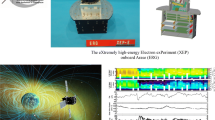Abstract
The Suprathermal Electron (STE) instrument, part of the IMPACT investigation on both spacecraft of NASA’s STEREO mission, is designed to measure electrons from ∼2 to ∼100 keV. This is the primary energy range for impulsive electron/3He-rich energetic particle events that are the most frequently occurring transient particle emissions from the Sun, for the electrons that generate solar type III radio emission, for the shock accelerated electrons that produce type II radio emission, and for the superhalo electrons (whose origin is unknown) that are present in the interplanetary medium even during the quietest times. These electrons are ideal for tracing heliospheric magnetic field lines back to their source regions on the Sun and for determining field line lengths, thus probing the structure of interplanetary coronal mass ejections (ICMEs) and of the ambient inner heliosphere. STE utilizes arrays of small, passively cooled thin window silicon semiconductor detectors, coupled to state-of-the-art pulse-reset front-end electronics, to detect electrons down to ∼2 keV with about 2 orders of magnitude increase in sensitivity over previous sensors at energies below ∼20 keV. STE provides energy resolution of ΔE/E∼10–25% and the angular resolution of ∼20° over two oppositely directed ∼80°×80° fields of view centered on the nominal Parker spiral field direction.
Similar content being viewed by others
References
S.D. Bale, P.J. Kellogg, K. Goetz, S.J. Monson, Transverse z-mode waves in the terrestrial electron foreshock. Geophys. Res. Lett. 25, 9–12 (1998)
S.D. Bale, M.J. Reiner, J.-L. Bougeret, M.L. Kaiser, S. Krucker, D.E. Larson, R.P. Lin, The source region of an interplanetary type II radio burst. Geophys. Res. Lett. 26, 1573–1576 (1999)
H.V. Cane, W.C. Erickson, Energetic particle propagation in the inner heliosphere as deduced from low-frequency (<100 kHz) observations of type III radio bursts. J. Geophys. Res. 108, 1203 (2003)
R.E. Ergun et al., Wind spacecraft observations of solar impulsive electron events associated with solar type III radio bursts. Astrophys. J. 503, 435–445 (1998)
J.T. Gosling et al., Solar electron bursts at very low energies: Evidence for acceleration in the high corona? Geophys. Res. Lett. 30(13), 1697–1700 (2003)
D.K. Haggerty, E.C. Roelof, Impulsive near-relativistic solar electron events: Delayed injection with respect to solar electromagnetic emission. Astrophys. J. 579, 841–853 (2002)
S. Holland, Fabrication of detectors and transisitors on high-resistivity silicon. Nucl. Instrum. Methods Phys. Res. A275, 537–541 (1989)
S.E. Holland et al., Development of low noise, back-side illuminated silicon photodiode arrays. IEEE Trans. Nucl. Sci. 44, 443–447 (1997)
Kaiser et al., The STEREO Mission: An Introduction. Space Sci. Rev. (2007, this issue). doi:10.1007/s11214-007-9277-0
S. Krucker et al., On the origin of impulsive electron events observed at 1 AU. Astrophys. J. 519, 864–875 (1999)
D.E. Larson, R.P. Lin et al., Tracing the topology of the October 18–20, 1995, magnetic cloud with ∼0.1–102 keV electrons. Geophys. Res. Lett. 24, 1911 (1997)
R.P. Lin, Energetic solar electrons in the interplanetary medium. Sol. Phys. 100, 537–561 (1985)
R.P. Lin, Observations of the 3D distributions of thermal to near-relativistic electrons in the interplanetary medium by the Wind spacecraft, in Coronal Physics from Radio and Space Observations, ed. by G. Trottet. Lecture Notes in Physics, vol. 483 (Springer, Berlin, 1997), p. 93
R.P. Lin, W.K. Levedahl, W. Lotko, D.A. Gurnett, F.L. Scarf, Evidence for nonlinear wave-wave interactions in solar type III radio bursts. Astrophys. J. 308, 954 (1986)
R.P. Lin et al., A three-dimensional plasma and energetic particle investigation for the wind spacecraft. Space Sci. Rev. 71, 125–153 (1995)
R.P. Lin et al., Observation of an impulsive solar electron event extending down to ∼0.5 keV energy. Geophys. Res. Lett. 23, 1211–1214 (1996)
R.P. Lin, B.R. Dennis, G.J. Hurford et al., The Reuven Ramaty High-Energy Solar Spectroscopic Imager (RHESSI). Sol. Phys. 210, 3–32 (2002)
J.G. Luhmann et al., STEREO IMPACT investigation goals, measurements, and data products overview. Space Sci. Rev. (2007, this issue). doi:10.1007/s11214-007-9170-x
D. Maia, M. Pick, Astrophys. J. 609, 1082–1097 (2004)
E. Mobius, D. Rucinski, M.A. Lee, P.A. Isenberg, Decreases in the antisunward flux of interstellar pickup He+ associated with radial interplanetary magnetic field. J. Geophys. Res. 10, 257 (1998)
D.V. Reames et al., Solar 3He-rich events and nonrelativistic electron events—A new association. Astrophys. J. 292, 716–724 (1985)
Sauvaud et al., Space Sci. Rev. (2007, this issue). doi:10.1007/s11214-007-9174-6
G.M. Simnett et al., The acceleration and release of near-relativistic electrons by coronal mass ejections. Astrophys. J. 579, 854–862 (2002)
C.S. Tindall, N.P. Palaio, B.A. Ludewigt, S.E. Holland, D.E. Larson, D.W. Curtis, S.E. McBride, T. Moreau, R.P. Lin, V. Angelopoulos, Silicon detectors for low energy particle detection. Trans. Nucl. Sci. (2008, to be submitted)
L. Wang, R.P. Lin, S. Krucker, J.T. Gosling, Evidence for double injections in scatter-free solar impulsive electron events. Geophys. Res. Lett. 33, L03106 (2006a). doi:10.1029/2005GL024434
Y.-M. Wang, M. Pick, G.M. Mason, Coronal holes, jets, and the origin of 3He-rich particle events. Astrophys. J. 639, 495 (2006b)
Author information
Authors and Affiliations
Corresponding author
Rights and permissions
About this article
Cite this article
Lin, R.P., Curtis, D.W., Larson, D.E. et al. The STEREO IMPACT Suprathermal Electron (STE) Instrument. Space Sci Rev 136, 241–255 (2008). https://doi.org/10.1007/s11214-008-9330-7
Received:
Accepted:
Published:
Issue Date:
DOI: https://doi.org/10.1007/s11214-008-9330-7




